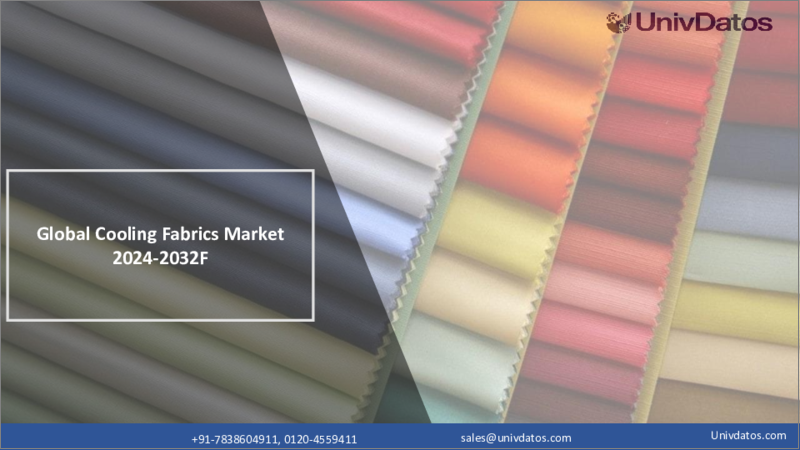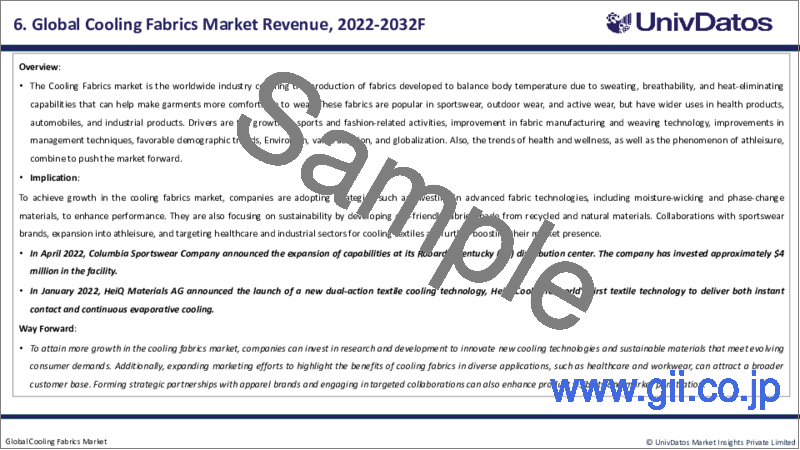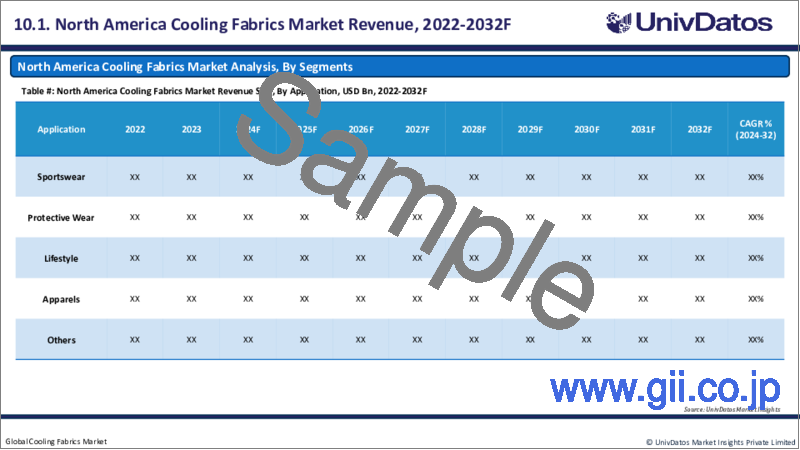|
|
市場調査レポート
商品コード
1591760
冷却ファブリック市場:現状分析と予測(2024-2032年)Cooling Fabrics Market: Current Analysis and Forecast (2024-2032) |
||||||
カスタマイズ可能
|
|||||||
| 冷却ファブリック市場:現状分析と予測(2024-2032年) |
|
出版日: 2024年10月01日
発行: UnivDatos Market Insights Pvt Ltd
ページ情報: 英文 144 Pages
納期: 即日から翌営業日
|
全表示
- 概要
- 目次
冷却ファブリック市場は約7.78%の成長率を示すと予測されています。これは、冷却ファブリックがヘルスケア製品に使用され、特に熱に敏感な患者の過熱を防ぐためです。また、この業界における研究開発、投資、製品の進歩、提携の増加が冷却ファブリック市場を牽引しています。例えば、2023年3月、NILITは冷却ファブリックを製造する主要ブランドSENSIL ByNatureの国際持続可能性・炭素認証プラスシステム(ISCC+)認定を取得しました。
タイプ別に見ると、市場は天然と合成に二分されます。冷却ファブリック市場では、持続可能な素材を日常生活に取り入れる必要性を消費者が認識していることから、天然素材のカテゴリーが最大の市場シェアを占めると予想されます。エコロジーの問題に敏感な人が増えているため、通気性と速乾性に優れた綿、麻、竹、ウールなどの天然素材を好む衣料品消費者が増えています。また、モヘアやシルクなどの天然繊維は、保温性が高く着心地がよいため、アクティブウェアやアウトドア用として重宝されています。また、これらの素材は加工技術の向上により性能が最適化されるため、環境に優しいクーラーを求める消費者にもアピールできます。このような天然素材、通気性素材へのニーズを実現することは、パフォーマンスウェアへのニーズに応えるだけでなく、全体的な持続可能なファッションの動きにも対応し、市場の成長をさらに促進します。
市場は生地の種類によって、織物、不織布、ニットに区分されます。このうち、織物分野は冷却ファブリック市場の主要促進要因です。織物タイプは、世界的に冷却ファブリック市場に大きく貢献しており、アスレチックウェアやアウトドアウェアに重要な耐久性と水分管理を提供しています。布帛を使用した最適な素材には、シャツ、パンツスーツ、スポーツジャケットなどがあります。ニット素材に比べ、生地表面の通気性が良く、湿気を逃がすことができるからです。そのため、運動に参加する際に不快にならない服装を必要とするアスリートやその他の活動的な人々に適しています。さらに、製織工程の発展により、これらの素材の開発においてさまざまな繊維や加工を統合することが可能になり、冷却特性が向上しました。機能的かつ審美的なスポーツウェアを使用する傾向が急速に高まっているため、冷却効果のある織物が普及し、市場を牽引しています。
市場は用途に基づき、スポーツウェア、防護服、ライフスタイル、アパレル、その他に区分されます。なかでも、スポーツウェア分野は冷却ファブリック市場の主要促進要因となっています。着用者のパフォーマンスと快適性の向上を約束する高品質素材の使用への注目が高まっているためです。今日の世界では、より多くの顧客が水分や体温を調節するのに役立つ服を求めているため、生産者は効果的に皮膚から汗を引き離し、冷却効果を提供する新しい冷却ファブリックを発表しています。これは、フィットネス活動やその他のアウトドアスポーツの増加、スポーツウェアをカジュアルウェアとして着用する一般的な傾向によって裏付けられています。そのため、各ブランドはハイテク生地の開発に力を入れており、アマチュアやプロのアスリートをターゲットにした、より多くの冷却スポーツウェア製品が市場に投入され、市場の成長を牽引しています。
冷却ファブリックの市場導入に関する理解を深めるため、市場は北米(米国、カナダ、その他北米地域)、欧州(ドイツ、英国、フランス、スペイン、イタリア、その他欧州地域)、アジア太平洋地域(中国、日本、インド、その他アジア太平洋地域)、世界のその他の地域における世界のプレゼンスに基づいて分析されています。中でも北米の冷却ファブリック市場は、スポーツウェア、アウトドアウェア、ホームテキスタイルなど、さまざまな分野でより良いファブリックへの需要が高まっていることを主因として増加傾向にあります。この成長は、消費者が衣服やウェアラブルを購入する健康志向の動向、特に温暖な気候のために、身体活動中の身体の快適さをサポートする優れたファブリックを必要とすることによる。スポーツウェアやアウトドア企業の大手ブランドは、スタイル、快適性、環境への影響を意識するようになった大規模な顧客のために、より優れた冷却技術や環境に配慮した生産素材を使用したスタイリッシュな衣類を調達しています。さらに、繊維産業の急成長に伴い、繊維技術の成長と研究開発への取り組みが市場を根本的に支えています。また、小売店のネットワークが発達していることや、アスレジャー分野が常に開拓されていることも、北米の冷却ファブリック市場の成長を後押ししています。
市場に参入している主要企業には、Coolcore; Ahlstrom; Asahi Kasei Advance Corporation; FORMOSA TAFFETA CO., LTD.; HeiQ Materials AG; NAN YA PLASTICS CORPORATION; Polartec LLC; NILIT; HexArmor; Nanostitchなどがあります。
目次
第1章 市場イントロダクション
- 市場の定義
- 主な目的
- ステークホルダー
- 制限事項
第2章 調査手法または前提条件
- 調査プロセス
- 調査手法
- 回答者プロファイル
第3章 エグゼクティブサマリー
- 業界要約
- セグメント別見通し
- 市場成長の強さ
- 地域展望
第4章 市場力学
- 促進要因
- 機会
- 抑制要因
- 動向
- PESTEL分析
- 需要側分析
- 供給側分析
- 合併と買収
- コラボレーションと投資とシナリオ
- 業界考察:大手スタートアップ企業とその独自の戦略
第5章 価格分析
- 地域別価格分析
- 価格に影響を与える要因
第6章 世界の冷却ファブリック市場収益 , 2022-2032年
第7章 市場洞察:タイプ別
- 天然
- 合成
第8章 市場洞察:生地の種類別
- 織物
- 不織布
- ニット
第9章 市場洞察:用途別
- スポーツウェア
- 防護服
- ライフスタイル
- アパレル
- その他
第10章 市場洞察:地域別
- 北米
- 米国
- カナダ
- その他北米地域
- 欧州
- ドイツ
- 英国
- フランス
- イタリア
- スペイン
- その他欧州地域
- アジア太平洋地域
- 中国
- 日本
- インド
- その他アジア太平洋地域
- 世界のその他の地域
第11章 バリューチェーン分析
- 限界分析
- 市場参入企業一覧
第12章 競合情勢
- 競合ダッシュボード
- 競合市場ポジショニング分析
- ポーターのファイブフォース分析
第13章 企業プロファイル
- Coolcore
- Company Overview
- Key Financials
- SWOT Analysis
- Product Portfolio
- Recent Developments
- Ahlstrom
- Asahi Kasei Advance Corporation
- FORMOSA TAFFETA CO., LTD.
- HeiQ Materials AG
- NAN YA PLASTICS CORPORATION
- Polartec LLC
- NILIT
- HexArmor
- Nanostitch
第14章 頭字語と前提条件
第15章 付録
The Cooling Fabrics market is the worldwide industry covering the production of fabrics developed to balance body temperature due to sweating, breathability, and heat-eliminating capabilities that can help make garments more comfortable to wear. These fabrics are popular in sportswear, outdoor wear, and active wear, but have wider uses in health products, automobiles, and industrial products. Drivers are the growth in sports and fashion-related activities, improvement in fabric manufacturing and weaving technology, improvements in management techniques, favorable demographic trends, Envirotech, value addition, and globalization. Also, the trends of health and wellness, as well as the phenomenon of athleisure, combined to push the market forward.
The Cooling Fabrics market is set to show a growth rate of about 7.78%. This is due to cooling fabrics being used in healthcare products to prevent overheating in patients, particularly for those with conditions that make them sensitive to heat. Also, increasing R&D, investment, product advancements, and collaborations in this industry drive the Cooling Fabrics market. For instance, in March 2023, NILIT earned the International Sustainability and Carbon Certification Plus system (ISCC+) accreditation for its primary brand SENSIL ByNature, which manufactures cooling fabrics.
Based on the type, the market is bifurcated into natural and synthetic. The natural category is expected to have the largest market share of the cooling fabrics market through consumers' awareness of the need to adopt sustainable materials in their day-to-day lives. Because more people are becoming sensitive to ecological questions, a growing number of clothes consumers prefer a natural fabric that comprises cotton, linen, bamboo, and wool as they provide breathability and are quick-dry. Such natural fibers as mohair, silk, and others can give good heat control and comfort, which makes the fabrics useful for activewear and outdoor purposes. Also, the improved processing technology of these materials optimizes their performance features, therefore appealing to consumers who seek to make eco-friendly coolers. Implementing this need for natural, breathable fabrics, not only caters to the need for performance wear but also the overall sustainable fashion movement, furthering market progression.
Based on the fabric type, the market is segmented into woven, non-woven, and knitted. Among these, the woven segment is a key driver of the cooling fabrics market. The woven category contributes greatly to the cooling fabrics market globally and provides durability and moisture management crucial for athletic and outdoor wear. Some of the best materials using woven build include shirts, trousers suits, and sports jackets because the fabric surfaces have better air circulation and are capable of wicking off moisture compared to many knitted fabrics. This makes them fit athletes and other active people who need outfits that do not make them uncomfortable when participating in exercises. Furthermore, developments in the weaving processes have enabled the integration of various fibers and treatments in the development of these materials, which improve their cooling characteristics. Since there is a rapidly growing trend towards the use of functional and aesthetic sportswear cooling woven fabrics have become popular and hence propelling the market forward.
Based on the application, the market is segmented into sportswear, protective wear, lifestyle, apparels, and others. Among these, the sportswear segment is a key driver of the cooling fabrics market. Due to increasing focus on the use of high-quality materials that promise to enhance wearer performance and comfort. In today's world, more customers are looking for clothes that help regulate moisture and temperature, which is why producers are introducing new cooling fabrics that effectively pull sweat away from the skin and provide a cooling effect. This is backed up by the increasing uptake of fitness activities and other outdoor sports together with the general trend of wearing sports apparel as casual wear. Hence, brands are focusing on the development of high-tech fabrics, and thus more and more cooling sportswear products are being launched in the market targeting amateur and professional athletes, thus driving the growth of the market.
For a better understanding of the market adoption of cooling fabrics, the market is analyzed based on its worldwide presence in countries such as North America (U.S., Canada, and the Rest of North America), Europe (Germany, U.K., France, Spain, Italy, Rest of Europe), Asia-Pacific (China, Japan, India, Rest of Asia-Pacific), Rest of World. Among these, the cooling fabrics market in North America is also on the rise mainly due to the demand for better fabrics in different sectors such as sportswear, outdoor wear, and home textiles. This growth is driven by trends in health consciousness where consumers buy clothes and wearables, especially for warmer climates requiring better fabric that supports bodily comfort during physical activities. Large brands in sportswear and outdoor companies are sourcing stylish clothing made from better cooling technologies and environmentally conscious production materials for their massive customers who are now conscious of style, comfort, and environmental impacts. Further, with the rapid growth in the textile industry, growth in textile technology and commitment to R&D are yet to aid the market fundamentally. There is also the favorable background of a well-developed network of retail outlets, and the constant development of the athleisure segment, all of which - assist in the growth of the cooling fabrics market in North America.
Some major players running in the market include Coolcore; Ahlstrom; Asahi Kasei Advance Corporation; FORMOSA TAFFETA CO., LTD.; HeiQ Materials AG; NAN YA PLASTICS CORPORATION; Polartec LLC; NILIT; HexArmor; Nanostitch.
TABLE OF CONTENTS
1.MARKET INTRODUCTION
- 1.1. Market Definitions
- 1.2. Main Objective
- 1.3. Stakeholders
- 1.4. Limitation
2.RESEARCH METHODOLOGY OR ASSUMPTION
- 2.1. Research Process of the Global Cooling Fabrics Market
- 2.2. Research Methodology of the Global Cooling Fabrics Market
- 2.3. Respondent Profile
3.EXECUTIVE SUMMARY
- 3.1. Industry Synopsis
- 3.2. Segmental Outlook
- 3.2.1. Market Growth Intensity
- 3.3. Regional Outlook
4.MARKET DYNAMICS
- 4.1. Drivers
- 4.2. Opportunity
- 4.3. Restraints
- 4.4. Trends
- 4.5. PESTEL Analysis
- 4.6. Demand Side Analysis
- 4.7. Supply Side Analysis
- 4.7.1. Merger & Acquisition
- 4.7.2. Collaboration & Investment and Scenario
- 4.7.3. Industry Insights: Leading Startups and Their Unique Strategies
5.PRICING ANALYSIS
- 5.1. Regional Pricing Analysis
- 5.2. Price Influencing Factors
6.GLOBAL COOLING FABRICS MARKET REVENUE (USD BN), 2022-2032F
7.MARKET INSIGHTS BY TYPE
- 7.1. Natural
- 7.2. Synthetic
8.MARKET INSIGHTS BY FABRIC TYPE
- 8.1. Woven
- 8.2. Non-woven
- 8.3. Knitted
9.MARKET INSIGHTS BY APPLICATION
- 9.1. Sportswear
- 9.2. Protective Wear
- 9.3. Lifestyle
- 9.4. Apparels
- 9.5. Others
10.MARKET INSIGHTS BY REGION
- 10.1. North America
- 10.1.1. U.S.
- 10.1.2. Canada
- 10.1.3. Rest of North America
- 10.2. Europe
- 10.2.1. Germany
- 10.2.2. U.K.
- 10.2.3. France
- 10.2.4. Italy
- 10.2.5. Spain
- 10.2.6. Rest of Europe
- 10.3. Asia-Pacific
- 10.3.1. China
- 10.3.2. Japan
- 10.3.3. India
- 10.3.4. Rest of Asia-Pacific
- 10.4. Rest of World
11.VALUE CHAIN ANALYSIS
- 11.1. Marginal Analysis
- 11.2. List of Market Participants
12.COMPETITIVE LANDSCAPE
- 12.1. Competition Dashboard
- 12.2. Competitor Market Positioning Analysis
- 12.3. Porter Five Forces Analysis
13.COMPANY PROFILED
- 13.1. Coolcore
- 13.1.1. Company Overview
- 13.1.2. Key Financials
- 13.1.3. SWOT Analysis
- 13.1.4. Product Portfolio
- 13.1.5. Recent Developments
- 13.2. Ahlstrom
- 13.3. Asahi Kasei Advance Corporation
- 13.4. FORMOSA TAFFETA CO., LTD.
- 13.5. HeiQ Materials AG
- 13.6. NAN YA PLASTICS CORPORATION
- 13.7. Polartec LLC
- 13.8. NILIT
- 13.9. HexArmor
- 13.10. Nanostitch





